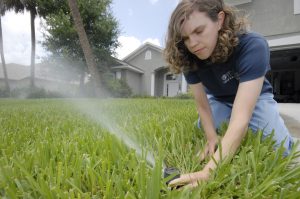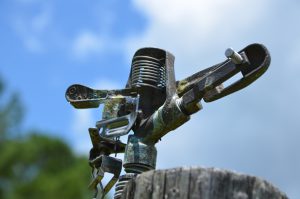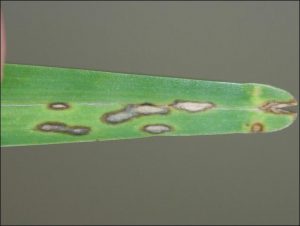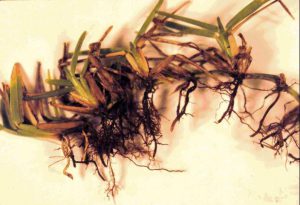by Matt Lollar | Jun 21, 2018
Are you interested in growing squash in your garden? Do you know the difference between summer squash and winter squash? Check out this very informative instructional video on growing squash in your home garden by Walton County Agriculture Agent Evan Anderson.
[youtube https://www.youtube.com/watch?v=hlbJfV-0FuU&w=560&h=315]
by Mary Salinas | May 23, 2018
A healthy lawn is a joy to stroll, relax and play on. It can also be part of an environmentally friendly landscape. But, sometimes it can seem to be a mystery on how to achieve that lush, healthy lawn in the Florida environment. Since we have lots of sandy soils and experience long periods of warm and hot weather, many suppose that giving the lawn lots of water will help do the trick. Not so.

Photo credit: UF/IFAS.
But what harm can it cause to give the lawn plenty of water all the time? Isn’t that a good thing? No! Overwatering your lawn can lead to the following problems:
- Development of fungal diseases (fungi love a moist environment!)
- Increased insect pest pressure
- More rapid thatch development
- More weeds (those little emerging weed seedlings thrive on consistent moisture!)
- Some weeds, like dollarweed and sedges, can be an indication of overwatering
- A shallow root system when frequent, light watering is applied
- Washing away of fertilizer down into the soil past the root system
- Higher water bills.
Our lawns need, on average, about 1/2 to 3/4 “of water a week during the summer. This recommendation changes depending on soil type, shade, temperature, wind, and season. To figure out how long to run your sprinklers, watch this YouTube video from UF/IFAS.
We recommend running your automated system only when your lawn shows signs of needing water such as:
- Leaf blades fold
- The lawn looks ‘off-color’
- Footprints remain and are visible
For more information:
Watering Your Florida Lawn
Gardening Solutions: Irrigation
Your Florida Lawn
by Les Harrison | Aug 11, 2017
July’s hot summer weather has given way to August’s 31 days of what will likely be temperatures and humidity equally elevated and intense. Wishes for November’s cooler thermometer reading are already creeping into daily conversations. The lawns and gardens in Wakulla County have rains as a mitigating factor to counteract the wilting potential of normal to excessive temperature readings. Unfortunately the arrival of water from above is not on a set or easily predictable schedule.
Traditionally, summer is the wettest season in Florida, with more than half of the annual rainfall occurring during the June to September “wet season”. Florida’s highest average annual rainfall occurs in the Panhandle with averages exceeding 60 inches per year. The Pensacola and Tallahassee weather stations are listed among the ten “wettest” stations in the nation. Still, this pattern of seasonal precipitation can vary greatly between locations, years and even days. This variability often results in the need to water the lawn, landscape and garden. By following a few guidelines, you can produce the best results for plants under stress and conserve a vital and limited resource.
It is most efficient to apply water between 5:00 a.m. and 10:00 a.m. for several reasons. Only water that is in contact with roots can be absorbed by the plant. If water is applied after 10:00 a.m., a substantial portion of it will evaporate before it reaches the roots; more will then need to be applied and this resource’s productivity will be reduced. Never water late in the afternoon as evaporation will still be a problem, and wet turf and plants will invite a variety of fungal diseases to flourish as night settles.

Photo Courtesy: Les Harrison, UF/IFAS Wakulla County Extension
In the case of landscapes and gardens, water should be applied only when the moisture in the root zone system has been depleted to an unacceptable level, usually by 1/2 to 2/3 of the stored soil-water. There are several ways to determine when the soil-water reservoir has been depleted beyond an acceptable level. The simplest method is a visual inspection of the turf or plants. Common symptoms of water stress include leaf color changes to a bluish-gray tint, footprints which linger long after being pressed into the grass and curled or folded leaf blades. Be sure the sprinklers are delivering water to the target area as water which misses the soil and is applied to hard surfaces such as driveways and sidewalks will be wasted. It also may pose an environmental problem in the form of runoff. Surface runoff that flows past the landscape will usually reach streams, ponds, or the Gulf of Mexico. If it picks up pollutants along the way, they too will reach the surface water bodies.
Over watering can be just as damaging as too little water. Excessive irrigation water can infiltrate the ground and reach groundwater aquifers. This issue is complicated when groundwater runs close to the surface. Excessive nutrients or pollutants can be discharged into surface bodies or move vertically into the deeper land layers. The connected springs and sinkholes in Wakulla County make the movement of surface water a common concern. Responsible and efficient irrigation will have positive effects far beyond the front yard.
To learn more about the effective use of water in Wakulla County’s landscapes, contact your UF/IFAS Wakulla Extension Office at 850-926-3931 or http://wakulla.ifas.ufl.edu/
by Mark Tancig | Aug 1, 2017
Florida’s panhandle has received quite a bit of rain this summer. In the last three months, depending on the location, approximately 15 to 35 inches of rain have come down, with the western panhandle on the higher end of that range. In addition to the rain, we all know how hot it has been with heat index values in the triple digits. And who can forget the humidity?! Well, these weather conditions are just the right environmental factors for many types of fungi, some harmful to landscape plants, most not.
In the classification of living things, fungi are divided into their own Kingdom, separate from plants, animals, and bacteria. They are actually more closely related to animals than plants. They play an important role on the Earth by recycling nutrients through the breakdown of dead or dying organisms. Many are consumed as food by humans, others provide medicines, such as penicillin, while some (yeasts) provide what’s needed for bread and beer. However, there are fungi that also give gardeners and homeowners headaches. Plant diseases caused by various fungi go by the names rusts, smuts, or a variety of leaf, root, and stem rots. Fungal pathogens gardeners may be experiencing during this weather include:
- Gray leaf spot – This fungus can often show up in St. Augustine grass lawns. Signs of this fungus include gray spots on the leaf (very descriptive name!). This disease can cause thin areas of lawn and slow growth of the grass.

Gray leaf spot on St. Augustine grass. Credit: Phil Harmon/UF/IFAS.
- Take-all root rot – This fungus can attack all our warm-season turfgrasses, and may start as yellow leaf blades and develop into small to large areas of thin grass or bare patches. The roots and stolons of affected grasses will be short and black.

Signs of take all root rot. Credit: UF/IFAS.
Powdery mildew – This fungus can be found on many plants, from roses to cucumbers. It looks like white powder on the leaves and can lead to plant decline.
- Armillaria root rot – This fungus can infect a variety of landscape plants, including oaks, hickories, viburnums, and azaleas. Symptoms can include yellowing of leaves and branch dieback, usually in adjacent plants. Old hardwood stumps can harbor this fungus and lead to the infection of nearby ornamentals.
Because fungi are naturally abundant in the environment, the use of fungicides can temporarily suppress, but not eliminate, most fungal diseases. Therefore, fungicides are best used during favorable conditions for the particular pathogen, as a preventative tool.
Proper management practices – mowing height, fertilization, irrigation, etc. – that reduce plant stress go a long way in preventing fungal diseases. Remember that even the use of broadleaf specific herbicides can stress a lawn and exacerbate disease problems if done incorrectly. Since rain has been abundant, irrigation schedules should be adjusted to reduce leaf and soil moisture. Minimizing injury to the leaves, stems, and roots prevents stress and potential entry points for fungi on the move.
If you think your landscape plants are suffering from a fungal disease, contact your local Extension Office and/or visit the University of Florida’s EDIS website at http://edis.ifas.ufl.edu for more information.

by Ray Bodrey | Jun 29, 2017
 Although we’ve received much-needed rainfall of late, it’s still a struggle to manage moisture levels in our Panhandle landscapes this summer. During wet summer seasons, one recurring issue is that watering plants too much can have as much of an ill effect as not watering enough.
Although we’ve received much-needed rainfall of late, it’s still a struggle to manage moisture levels in our Panhandle landscapes this summer. During wet summer seasons, one recurring issue is that watering plants too much can have as much of an ill effect as not watering enough.
Shallow rooted plants, as well as newly set plants can easily become water stressed. Some people lightly water their plants each day. With this practice, one is only watering an inch or less of the topsoil. Most roots are deeper than this. Instead of a light watering every day, soaking the plant a few times a week works better. A soil that has been soaked will retain moisture for several days. This is a very good practice for young plants. In contrast, some people soak their plants to often. This essential drowns the roots by eliminating vital oxygen in the root zone. This can also cause root rot. Leaves that turn brown at the tips or edges, as well as leaf drop, are displaying signs of overwatering.
The following are tips from the UF/IFAS Florida-Friendly Landscape Program. These tips will help conserve water by providing best management practices for your landscape:
- Choose the right plant for the right place: Be sure to place plants in your landscape that match existing environmental conditions.
- Water Thoughtfully: Water early in the morning and water when plants and turfgrass start to wilt. Refrain from watering in the late afternoon or evening. This is when insects and diseases are most active.
- Perform regular irrigation maintenance: Remember, an irrigation system is only effective if it is maintained regularly. Check for and repair leaks. If using a pop-up heads for turfgrass, point heads away from driveways and sidewalks.
- Calibrate turfgrass irrigation system: Ideal amount of water to apply to turfgrass is ½”- ¾”. A simple test can be done to calibrate. Place a coffee or tuna cans throughout the landscape. Run the irrigation system for 30 minutes. Average the depth of the water containers. Adjust running time to apply the ½”- ¾” rate.
- Use micro-irrigation in gardens and individual plants: Drip, or microspray irrigation systems apply water directly to the root system with limited surface evaporation.
- Make a rain barrel: Rain barrels are an inexpensive way to capture rainwater from your roof. This can translate into a big impact on your water bill as well.
- Mulch plants: Mulch helps keep moisture in the root zone. Two to three inches in-depth, for a few feet in diameter will work well for trees, shrubs, flowers and vegetables.
- Mow correctly: Mowing your grass at the highest recommended length is key. Be sure to cut no more than 1/3 of the leaf blade each time you mow. Keep mowing blades sharp as dull cuts often cause grass to be prone to disease.
- Be a weather watcher: Wait at least 24 hours after a rainfall event to water. If rain is in the forecast, wait 48 hours until irrigating. Use a rain gauge or install a rain shut-off device to monitor irrigation scheduling.
For more information on water conservation principles contact your local county extension office.
Supporting information can be found at the UF/IFAS Center for Landscape Conservation & Ecology’s Drought Toolkit: http://clce.ifas.ufl.edu/drought_toolkit/






